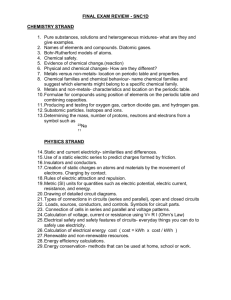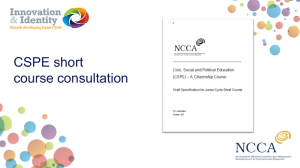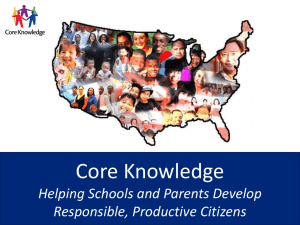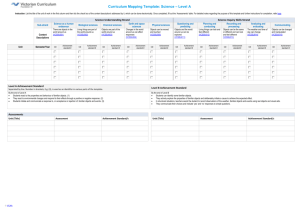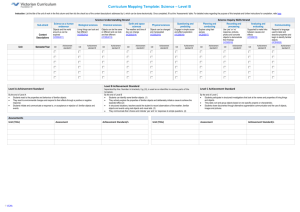Facilitator`s Guide: Introduction to the Skills Strand
advertisement
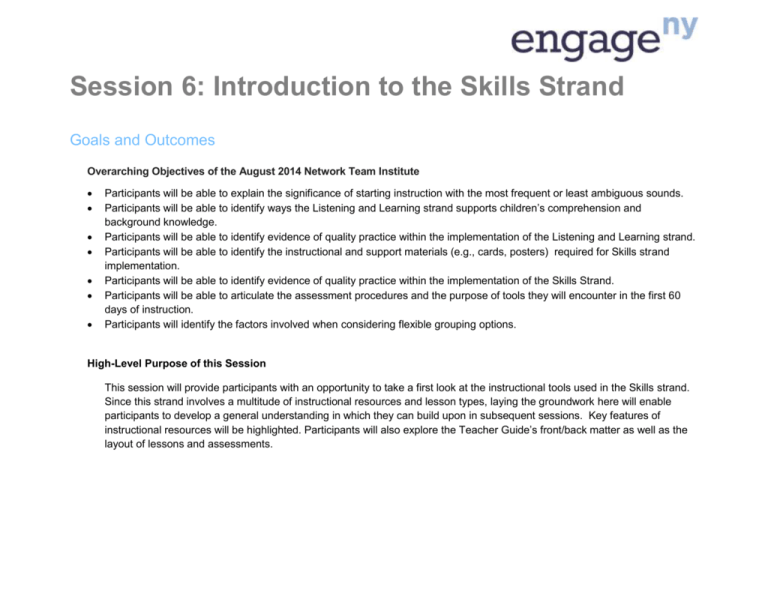
Session 6: Introduction to the Skills Strand Goals and Outcomes Overarching Objectives of the August 2014 Network Team Institute Participants will be able to explain the significance of starting instruction with the most frequent or least ambiguous sounds. Participants will be able to identify ways the Listening and Learning strand supports children’s comprehension and background knowledge. Participants will be able to identify evidence of quality practice within the implementation of the Listening and Learning strand. Participants will be able to identify the instructional and support materials (e.g., cards, posters) required for Skills strand implementation. Participants will be able to identify evidence of quality practice within the implementation of the Skills Strand. Participants will be able to articulate the assessment procedures and the purpose of tools they will encounter in the first 60 days of instruction. Participants will identify the factors involved when considering flexible grouping options. High-Level Purpose of this Session This session will provide participants with an opportunity to take a first look at the instructional tools used in the Skills strand. Since this strand involves a multitude of instructional resources and lesson types, laying the groundwork here will enable participants to develop a general understanding in which they can build upon in subsequent sessions. Key features of instructional resources will be highlighted. Participants will also explore the Teacher Guide’s front/back matter as well as the layout of lessons and assessments. Related Learning Experiences This two day training is designed as a curricular kick-off to support instructional leadership teams and teachers who plan on implementing Core Knowledge Language Arts (CKLA) in the coming school year. While this training module is a new launch, individuals who have participated in previous CKLA sessions can use this as an opportunity to reground in the content. This module will not extend beyond the content of previous trainings. During the first day of training, participants will develop a deep understanding of the guiding instructional design principles around which the two strands of CKLA (Listening & Learning and Skills) were created. “Lessons learned” from the field will also be shared, and participants will have an opportunity to reflect as a team on the instructional implications. Participants will also have an opportunity to review materials of the Listening & Learning strand and see implementation in action. The second day will orient participants to the Skills strand of the CKLA. Participants will have an opportunity to use materials, curricular lesson types, and support tools critical to high-quality implementation (including tools for assessment, placement, grouping, and monitoring of students). Finally, participants will be provided resources to facilitate home-to-school connections about CKLA. This includes a turnkey presentation for a back-to-school night, answers to key frequently asked questions, and a highlight of embedded curricular materials to support connections between the home and classroom. Session Outcomes What do we want participants to be able to do as a result of this session? In this session participants will be able to: identify the instructional and support materials (e.g., cards, posters) required for Skills strand implementation. identify key features of the Teachers Guide. How will we know that they are able to do this? Participants will demonstrate understanding through a scavenger hunt activity. Session Overview Section Time Overview Section 1. 3 Session Overview, review of design principles as it pertains to the Skills Strand min Section 2 7 Overview of Skills Strand Materials min Prepared Resources Instructors will frame session and upcoming sessions on the Skills Strand. This will lay down a foundation that we will build upon as participants to examine this strand in more depth through sessions 7–11. Gather Skills materials (see prepared resources) As a reminder of why the program is structured as it is, quick review of the four key design principles. Instructors will provide an overview of Materials used in Skills strand. Facilitator’s Preparation Samples of Skills Strand materials: Teacher’s Guide, Student Workbooks, Student Readers, Big Books, Blending Picture Cards, Sound Poster Set & Sound Cards, Large Card Letter Set, Student Chaining Folder, Small Letter Cards, Code Flip Books, Spelling Cards, Individual Code Chart, Timeline Posters & Timeline Cards, Assessment and Remediation Guide Handouts: August2014_Session6__SkillsIntro_VisualComponentGuide Video: Students Love Student Readers http://vimeo.com/coreknowledge/review/98650729/1bb8eb5 754 Code Flip Books http://vimeo.com/coreknowledge/review/98641764/ec4156c 015 Large Letter Cards http://vimeo.com/coreknowledge/review/98646631/73935dfe 72 Section 3 Unpacking the Skills Strand Teacher’s Guide 45 min Participants will take a closer look at the Teacher Guide ACTIVITY: Participants will work in pairs to complete a scavenger hunt using one of the Teacher Guides they brought to the training. Through their search they will examine components of the instructor guide. DEBRIEF: Discuss what they found and reflected on while reviewing the Teacher Guide. Student Readers: Kindergarten Students Read Whole Group http://vimeo.com/coreknowledge/review/98652563/8bda72 648e Kindergarten Student Reads Independently https://vimeo.com/coreknowledge/review/98656001/a9172e 2cce Second Grade Students-CLOSE Read Lesson http://vimeo.com/coreknowledge/review/97980274/fb6ad7c7e8 Chaining Folders http://vimeo.com/coreknowledge/review/98658040/99e054f a51 Handouts: Skills Unit1Teacher’s Guides August2014_Session6_SkillsIntro_ScavengerHunt Activity Cards: August2014_Session6_SkillsIntro_ScavengerHuntCards Session Roadmap Section 1: Introduction to the Skills Strand: Framing the Skills Strand Sessions Time Slide #/Pic of Slide Slide 2 Time: 3 minutes Script/Activity directions Grouping WG Slide 3 Slide 4 Key Points: In this session you will be able to: Identify the instructional and support materials (e.g., cards, posters) required for Skills strand implementation. Identify key features of the Teachers Guide Key Points: As a reminder of why the program is structured as it is, we want to review the key design principles for the Skills strand As we introduce you to each piece of the CKLA materials needed to implement the Skills strand, you will learn about its purpose to uncover the intentional underlying design that explicitly supports instruction Section 2: Overview of Skills Strand Materials Time Slide #/Pic of Slide Slide 5 Time: 7 minutes Script/Activity directions Key Points: The CKLA program includes many components that are required to be used for effective implementation of the skill strand. There are materials for both teacher use and student use. Some are consumable. A list and description of all of the materials needed to implement CKLA Skills Strand is included in Appendix C in the back of the Skills Strand Unit 1 Teacher’s Guide for each grade. Students Love Student Readers http://vimeo.com/coreknowledge/review/986 50729/1bb8eb5754 Grouping WG Slide 6 Key Points: The Teacher’s Guide is the central component for the teaching the Skills Strand effectively. The Skills Strand Teacher’s Guide provides the lessons, objectives, activities and support to guide your instruction. There is a Teacher’s Guide for every unit of the Skill strand and corresponds to each grade level scope and sequence. In Kindergarten there are 10 units, First Grade has 7 units and Second Grade has 6 units At the end of this session, you will have the opportunity to unpack the teacher’s guide and learn about its components in depth. Slide 7 Key Points: The purpose of the Big Books is to provide an opportunity for the teacher to model reading and concepts of print for students. Big Books are used during the Demonstration Story lessons. There are 5 titles in Kindergarten and 3 titles in First Grade. The Big Books are exact replicas of the student readers but larger. Slide 8 Key Points: The purpose of the Sound Posters and Sound Cards is to provide a visual reminder of the code knowledge students have been taught. Sound cards and Posters are provided in Kindergarten only. Slide 9 Key Points: The purpose of the Code Flip Book and Cards is to provide students with a visual guide of sounds and spellings taught. The Code Flip books are used in First and Second Grade. There is a set of two flip books, one for vowels and one for consonants. Code Flip Books http://vimeo.com/coreknowledge/review/986 41764/ec4156c015 Slide 10 Key Points: The purpose of the Large Letter Cards is to review sounds and spellings during warm-up activities for Kindergarten and First Grade and during Large Card Chaining Activities. One set of cards is provided per class. The set differs from K to First Grade in that the set reflects the sounds taught within the grade. The Large Letter cards are differentiated by shading for vowel sounds and a dark line on the bottom to cue directionality. Large Letter Cards http://vimeo.com/coreknowledge/review/986 46631/73935dfe72 Slide 11 Key Points: The purpose of the Blending Picture Cards is to support blending activities by using images to serve as a visual cue for blending a word. One set of blending cards is provided per teacher. The names consist of 2-3 sounds that are suitable for early blending practice. Slide 12 Key Point: The purpose of the Timeline Posters and cards is to help students understand the context and content of stories in the Grade 2 Skills Readers. Slide 13 Key Points: In addition to the teacher materials, there are student materials including workbooks, individual readers, student chaining folders in Kindergarten and individual sound code charts for students in first and second grade. All of these materials support students learning of sound –letter correspondences, handwriting, grammar, writing and reading. Slide 14 Key Points: The purpose of the student workbook is to provide practice and reinforcement for students after a lesson. There is one workbook per student, per unit. Workbook answer keys are located in the Teacher’s Guide. Teachers are encouraged to model practice for a few samples of the worksheets before having students work independently Slide 15 Key Points: The purpose of the Student Readers is to provide practice on recently taught spellings through 100% decodable text. There is a reader for units 6-10 in Kindergarten, 1-7 in First Grade and 1-6 in Second Grade New spellings taught in the unit are printed in bold throughout the reader to help students master new material. Students use readers for partner reading, independent reading and CLOSE reading lessons. Student Readers: Kindergarten Students Read Whole Group o http://vimeo.com/coreknowledge/revi ew/98652563/8bda72648e Kindergarten Student Reads Independently o https://vimeo.com/coreknowledge/rev Slide 16 iew/98656001/a9172e2cce Second Grade Students-CLOSE Read Lesson o http://vimeo.com/coreknowledge/review/ 97980274/fb6ad7c7e8 Key Points: The purpose of the Student Chaining Folders and small letter cards is to allow Kindergarten students to practice sound spellings taught. Student Chaining Folders provide students with individual opportunities to practice blending and segmenting This tool is used for chaining activities introduced in Kindergarten Skills Unit 5. Chaining Folders http://vimeo.com/coreknowledge/review/986 58040/99e054fa51 Slide 17 Key Points: The Assessment and Remediation Guide is an online resource that is aligned to instruction in the Skill strand units. This resource guide consists of both assessment and remediation materials that can be used to reinforce, reteach and progress monitor students. This grade 2 Fluency Packet consists of poetry, fiction, and nonfiction, as well as Reader's Theater selections. These additional text selections provide opportunities for students to practice reading with fluency and expression. Section 3: Unpacking the Skills Strand Teacher’s Guide Time 2:553:40 Slide #/Pic of Slide Slide 18 Time: 45 minutes Script/Activity directions Key Point: The focus is to unpack the Teacher’s Guide to dig deep learn more about its key features and main components Grouping WG, S Slide 19 Key Points: There are many key features to the Skills Strand Teacher’s Guides including the unit introduction, alignment chart, pacing chart, lessons, assessments, pausing points, appendices and teacher resources Becoming familiar with each of the guides components will aid with ease in planning and presentation of lessons. Slide 20 Activity: Participants will work independently or in pairs through a scavenger like activity to locate different components of the Skills Strand of the Teacher’s Guide using the Unit 1 Teacher’s guide for a grade of their choice. Participants will complete a task or answer a question on a Teacher’s Guide Activity card and record the answers. Slide 21 Activity: Locate the Skills Teacher Guide Scavenger Hunt Recording Sheet in the Participant Workbook. Slide 22 Activity: You will work independently or in pairs through a scavenger activity to locate different components of the Skills Strand of the Teacher’s Guide using the Unit 1 Teacher’s guide for a grade of your choice. Complete the question or tasks on the Teacher’s Guide Activity card and record the answers on your Skills scavenger hunt recording sheet in your workbook. Be sure to complete all tasks and be prepared to share. Slide 23 Activity: When instructed to do so, participants will share what they have learned about the specific Skills Strand Teacher’s Guide components with their table. Participants will then add the post- it’s with definitions to corresponding TG component posters around room. Slide 24 Key Points: The Skills introduction provides pertinent information specific to the instructional content of the unit. The information is meant to provide an orientation as to what you can expect and what you will need for instruction within the unit. It includes… (read slide) What else did you notice? Any questions about this? Slide 25 Key Points: One of the first things listed in the table of contents is the skills alignment chart. The alignment chart contains Core Content Objectives These detail the knowledge you are building through the lessons. The table of contents also included ELA goals and the key goals and ideas they align to. This lays out what ELA skills are addressed through the Anthology and what CCLS they align. Did you notice anything else? Any questions about this? Slide 26 Key Points: The content in each unit changes according to the sequence of instruction. The Table of Contents is a good place to start to see the lesson titles, path for instruction and location of pausing points, assessments and resources. The Pacing chart is similar to the Listening and Learning Pacing Chart. Laid out in a calendar format, it will provide the number of total days within the unit, titles of the exercises and suggested number of minutes allotted for each. The At-A-Glance chart is included in each Skills and L & L lesson. It provides the lesson component, exercise, and materials. Slide 27 Key Points: Note the a) Lesson number b) Lesson type c) Objectives for the lesson d) At a Glance Box e) Lesson support in margins f) Titles of component sections clearly marked g) Guided illustrations for hand gestures, arm gestures, or tripod grip h) Specific examples for oral language exercises /_/ denotes sound, ‘_’ denotes letter name Slide 28 Key Points: CKLA includes Pausing Point days for the units in the Skills strand and the domains in L &L Pausing point are days that have been designated to “pause” to practice what has been taught to date. No new content is taught on these days. The suggestion is to pause for 1 to 2 days depending upon calendar. The Appendices includes the Grade’s Skills scope and sequence in Unit 1 only. The articles include CKLA philosophy of pedagogy and instruction. Slide 29 Turnkey Materials Provided August2014_Session6_SkillsIntro_PPT Key Points: Quality implementation with high fidelity will lead to effective instruction. Teachers who have experienced the most success in the implementation of the Skills strand have followed these general guidelines.



